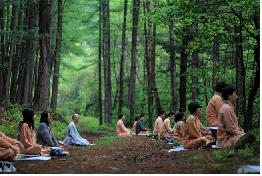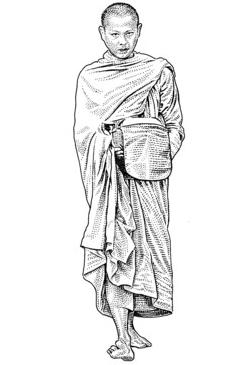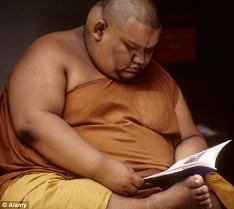Buddhist Contemplative Care Symposium set for November at the Garrison Institute
Buddhist Contemplative Care Symposium set for November at the Garrison Institute |
- Buddhist Contemplative Care Symposium set for November at the Garrison Institute
- For I Have Learned
- Feast in the fields to support Green Gulch Farm September 8
- Collected Works of Korean Meditation now available online
- Korean Buddhist cultural offerings designed to go global
- Video: Cary Groner — “Mercy Was In Short Supply”
- In Thailand Today, Teen Monks Express the Spirit to a Rock
- Thailand's Buddhist monks to get food lessons after study
| Buddhist Contemplative Care Symposium set for November at the Garrison Institute Posted: 16 Aug 2012 09:00 AM PDT
More information, including registration, is available here. Read More @ Source |
| Posted: 16 Aug 2012 08:00 AM PDT 
William Wordsworth Read More @ Source |
| Feast in the fields to support Green Gulch Farm September 8 Posted: 15 Aug 2012 03:00 PM PDT
The luncheon will feature meals planned by Greens Restaurant chef Annie Somerville, and prepared from the bounty of vegetables grown at the farm, as well organic beverages crafted by Mark Ellenbogen. Event speakers will include Wendy Johnson, Founding Gardener; Sara Tashker, Green Gulch Farm Director; Eric Gower, Breakaway Cook and author; Dave Stockdale, Executive Director of the Center for Urban Education and Sustainability; and Olivia Maki of 18 Reasons. Throughout the afternoon, there will be tours, music, a raffle and a program for children ages 5 – 12. More information, and tickets, are available here. Proceeds from the event will benefit the renovation of the Cloud Hall. Read More @ Source |
| Collected Works of Korean Meditation now available online Posted: 15 Aug 2012 02:00 PM PDT
"The Collected Works of Korean Meditation seeks to make available in accurate, idiomatic English translations the greatest works of the Korean Buddhist tradition, many of which are being rendered for the first time into any Western language," said Robert Buswell, the UCLA Buddhist studies professor who led the translation efforts, in the preface. Buswell explained that the thirteen new volumes collect Korean Buddhist writing from the Three Kingdoms Period, which began in 57 C.E., through the Joseon Dynasty, which ended in 1910. The texts include commentaries and teachings from important Korean scholars, as well as Seon gongan cases, discourses and verses, and historical documents and travelogues. Many of the texts are complete, and for longer pieces, the translators have offered a representative selection of excerpts. The table of contents for the thirteen volumes is available here; you can also download the complete text from the same page. (Painting: Jinul, public domain via Wikimedia Commons.) Read More @ Source |
| Korean Buddhist cultural offerings designed to go global Posted: 15 Aug 2012 01:00 PM PDT By Cho Chung-un, Korea Herald, Aug 14, 2012
Seoul, South Korea -- Buddhism is not just a religion in Korea. It is an integral cultural asset that has substantially contributed to the development of the country's tradition and arts for the last 1,700 years.
The Korean Buddhist culture now attempts to go abroad in an effort to better serve the rising global demand for learning about Korean history and culture, thanks to the popularity of K-pop around the world. The Cultural Corps of Korean Buddhism, an affiliate of the Jogye Order of Korean Buddhism, plans to develop various programs to promote its two signature cultural offerings ― templestays and temple food. Its latest development includes a Templestay program designed exclusively for K-pop fans from France created in collaboration with the Korea Tourism Organization. It also plans to open the first temple food restaurant on the rooftop of the French department store Galeries Lafayette in Paris next year.
Templestay is a cultural program that allows people to stay in mountainside temples and participate in Zen meditation, early-morning chanting and daily chores. "Through the Templestay, participants can learn the wisdom of monastic life and the philosophy of a peaceful co-existence with nature. The program is not only designed to offer cultural understanding but also to offer new direction for people struggling in the highly competitive society," said Ven. Deung Mok, deputy director of the Cultural Corps of Korean Buddhism. "Templestay will be developed into various programs and will continue to serve people's needs not only in Korea but also people coming from all over the world," he added. The number of temples offering Templestay programs across the country has surged from 33 in 2002 to 118 last year. About 1.9 million people have participated in the program as of late last year. In 2011 alone about 190,000 people, including 25,000 foreign travelers, joined the program, officials at the group said. The unique program has also contributed to enhancing Korea's image abroad. Templestay was selected as one of the most successful tourism items by the Organization for Economic Cooperation and Development in 2009. An OECD report titled "The Impact of Culture on Tourism" included Korea's Templestay program as a successful combination of culture and tourism, along with other strategic tourism sites such as the Vorarlberg Province in Austria, the State of Michoacan in Mexico and the Industrial Monuments Route of the Silesian Voivodeship in Poland. With the success of the project, Culture Ministry transferred the project from the Religious Affairs Office to Tourism Industry Bureau last year. "The government has decided to transfer the project to the tourism bureau because it is no longer about religious affairs but an important tourism resource for Korea," said Hong Seung-mo, an official at the department of tourism promotion. The government spends 20 billion won ($ 17.72 million) a year for developing various Korean Buddhist cultural content, from Templestay to temple food. The budget also includes expenditure on renovation at temples to help them better accommodate participants coming from all around the world. Temple food has been also drawing attention from abroad, particularly among the health-conscious in North America and Europe. To better promote the 1,700-year-old culinary assets, the Cultural Corps of Korean Buddhism is seeking ways of modernizing the recipes while preserving the traditional style of temple food. It also plans to provide recipes for nutritious vegetarian food and to hold a campaign against food wastage. The religious group has been holding seminars on temple food in the U.S. and also participated in ITV, an international tourism exhibition in Germany, earlier this year. Read More @ Source |
| Video: Cary Groner — “Mercy Was In Short Supply” Posted: 15 Aug 2012 12:00 PM PDT In this video, writer and Vajrayana Buddhist practitioner Cary Groner reads from his suspenseful novel Exiles. Exiles tells the story of Peter Scanlon, a cardiologist who decides to volunteer at a clinic in Nepal after his marriage falls apart. Peter brings his teenaged daughter with him, but they soon find that they're in increasing danger from Nepal's civil war. Along with Susan Dunlap and Kim Stanley Robinson, Groner is one of three Buddhist-inspired novelists Andrea Miller profiles in "Pure Fiction" in our September magazine. As Groner explains in the article, he stated writing Exiles because he was interested in the overlap between Buddhist and the sciences. While the finished book is much more action-packed than what he originally envisioned, the theme of science and religion is still present in a series of conversations between Peter, the American doctor, and a Tibetan lama. You can read an excerpt of "Pure Fiction" here, and to read the rest, including the section about Groner, his writing process and his meditation practice — as well as the interviews with Dunlap and Robinson — pick up a copy of our September 2012 magazine. To see what else is inside, click here. Read More @ Source |
| In Thailand Today, Teen Monks Express the Spirit to a Rock Posted: 15 Aug 2012 11:00 AM PDT By JAMES HOOKWAY, WSJ, Aug 14, 2012
Thailand's Buddhists are a bit annoyed with today's young monks. As mobile phones and other devices grow more popular, it's becoming harder for religious leaders to control the images of Buddhism in the media and marketplace. WSJ's James Hookway reports. BANGKOK, Thailand -- Each year as monsoon rains sweep their way over Thailand, tens of thousands of teenage boys shave their heads and are ordained as Buddhist monks in a traditional rite of passage.
Others post videos of themselves on YouTube, as they play air guitar to hard-rock tracks like Yngwie Malmsteen's "Iron Clad," or recite religious chants to thumping hip-hop beats. The Buddhist faith practiced by more than 90% of Thailand's population is going through something like culture shock as the country quickly modernizes alongside East Asia's other booming economies. With more Thais going online, often through mobile phones, some of the country's novice monks are becoming online media stars, jarring an older generation that doesn't quite know what to make of it all. "Technology is advancing very quickly and we can't keep up," said Phra Kasem Sanyato, secretary of the Buddhism Protection Center of Thailand, a watchdog for religious affairs. "The younger generation is losing respect," added 48-year-old Pornpun Kaewbundit, as she emerged from a temple in Bangkok's historic old town recently. Besides rocking out to Mr. Malmsteen, who was born in Sweden and lives in Florida, some monks film themselves playing pranks on other novices or shouting out lyrics to the likes of Thailand's heavy-metal band Bodyslam. They often use deodorant sticks or whatever else is at hand as stand-ins for microphones. Brooms often double as guitars.
The clips are quickly becoming a genre of their own on YouTube and other sites, with some users taking one clip and remixing it with fresh backing music. The result: mash-ups of monks with shaved heads cavorting about in wigs to Dead or Alive's 1980s hit "You Spin Me Round (Like A Record)." Monks old enough to know better are getting caught up in the excitement, too. Phra Klairung Rujidhammo was recently catapulted to national fame when he was filmed performing suggestive dance moves, known here as coyote dancing after the film "Coyote Ugly" set in a New York dance-bar. Phra Klairung, a chunky temple secretary in his mid-forties, quickly apologized after the clip went viral, explaining that he was trying to cheer people up after flooding hit the area around his temple in northern Bangkok. His superiors gave him a two-week suspension, and Phra (Phra is a religious title) Klairung is back collecting food offerings and other alms from the local community each morning. Some Thais, though, fear that the Buddhist clergy's standards are slipping. They are urging Thais to be a little less tolerant than the country's image as a magnet for night-clubbers and sun-seekers might suggest. Bangkok jeweler Acharavadee Wongsakon, for instance, on June 30 led a procession of several hundred protesters through the city's famous Chatuchak weekend market and the Khao San Road backpacker district to persuade Thais and foreign tourists to show more respect. That includes avoiding getting inked up with Buddhist tattoos. Accompanied by ornate floats and banners saying "No" to the Disney movie "Snow Buddies," which features a dog named Buddha, Ms. Acharavadee silenced the normally raucous backpackers who frequent the area as she and her followers made their way past bars with names such as Lucky Beer and the Lava Lounge. "I think they have a point," whispered 23-year-old Carla Bennett from Canada, who was getting her hair braided at a street stall at the side of the road. "Maybe they are tired of people stomping over what they believe in." During a breather between parades, Ms. Acharavadee complained that some Thais regard Buddhism as little more than a detail listed on their national identity cards. "The Internet is compounding the problem. People are spending less time studying Buddhism, and they are missing its message," she said. Another source of worry in religious circles is the fact that Thais are having fewer children than they used to as more families move from farms to the country's cities. Thai women now have an average of 1.5 children, down from more than six in the 1960s. That means fewer teenagers are ordained as novices. All Thai Buddhist males generally get ordained at some point in their lives, though most often in their teenage years and sometimes earlier. Some Buddhists are fighting fire with fire by turning to reality television shows and the Internet to revive interest in Buddhist teachings. Thai cable network True Corp. this year began airing a live, rolling documentary about the lives of nine novice monks ordained at a temple in eastern Bangkok. Snappily titled "Novice Monks Cultivate Dharma Wisdom," it was a surprise hit. One fan, 64-year-old Wallapa Chairat, says she gets up at 5:30 each morning to watch the young monks go around collecting alms. One day she got out of bed at 4 a.m. and left her house in Nonthaburi province near Bangkok to offer food to the young monks herself. "The news programs and soap operas are full of angry people who are jealous and fighting," Ms. Wallapa says. "But the little monks provide peace and happiness." The young monks seemed to enjoy it, too. "I think living in the monkhood is the best thing I've ever done in my life," 9-year-old Theerapath Suthipatharapan told the show after his stint in the temple was up. Unlike other reality shows, the monks aren't voted out by the audience. Source: http://online.wsj.com/article/SB10000872396390444025204577545350105074874.html Read More @ Source |
| Thailand's Buddhist monks to get food lessons after study Posted: 15 Aug 2012 10:00 AM PDT by Andrew Buncombe, The Independent, August 2, 2012
Bangkok, Thailand -- The Buddhist monks of Thailand are not known to be an especially active bunch. Prayers, chanting and the collecting of alms take up much of their time.
But a new study suggests this lack of activity is not as healthy as one would assume. The investigation by Thai academics has discovered that 45 per cent of monks are obese while a full 40 per cent of them suffer from congenital diseases such as diabetes and high blood pressure. Many of them also suffer from various allergies. The reason for this dismal situation, the scientists concurred, was an unhealthy diet and insufficient exercise. Much of the food donated to monks when they interact with the public is rich and oily and often contains too much sugar. In the evenings, when they are not supposed to eat, many of them will enjoy sweet soft drinks, usually also laden with sugar.
Along with this is an unhealthy lifestyle. A report in The Nation newspaper said that apart from making their walks for alms, their only real exercise was sweeping the courtyards of their temples. Just over 20 per cent of the monks have annual health check-ups. The survey's participants were 246 monks from the Dhammayuttika Nikaya and Mahayana movements in 11 of Thailand's provinces. The newspaper reported that following the investigation by Dr Pinij Larpthananon and Prof Jongjit Angkatavanich from Bangkok's Chulalongkorn University, and Dr Phramaha Suthit Aphakaro, director of the Buddhist research institute at Mahachulalongkornrajavidyalaya University, a dual track plan had been put into place. Not only will monks be educated about the sort of food they should be collecting, but a public education campaign will seek to advise people on healthy options they can give to the men in saffron robes. Read More @ Source |
| You are subscribed to email updates from BuddhaRocks ☸ Buddhist To stop receiving these emails, you may unsubscribe now. | Email delivery powered by Google |
| Google Inc., 20 West Kinzie, Chicago IL USA 60610 | |


 The Shambhala Sun Foundation is proud to sponsor
The Shambhala Sun Foundation is proud to sponsor  A massive collection of Korean Buddhist writing has been
A massive collection of Korean Buddhist writing has been  << This file photo shows participants at a Templestay program meditating in the woods with Korean Buddhist monks. (Cultural Corps of Korean Buddhism)
<< This file photo shows participants at a Templestay program meditating in the woods with Korean Buddhist monks. (Cultural Corps of Korean Buddhism) Some find their life's vocation during the few weeks they spend in the monastery, and they become full-time monks.
Some find their life's vocation during the few weeks they spend in the monastery, and they become full-time monks. << The monastic lifestyle isn't as healthy as one might expect, researchers found.
<< The monastic lifestyle isn't as healthy as one might expect, researchers found.